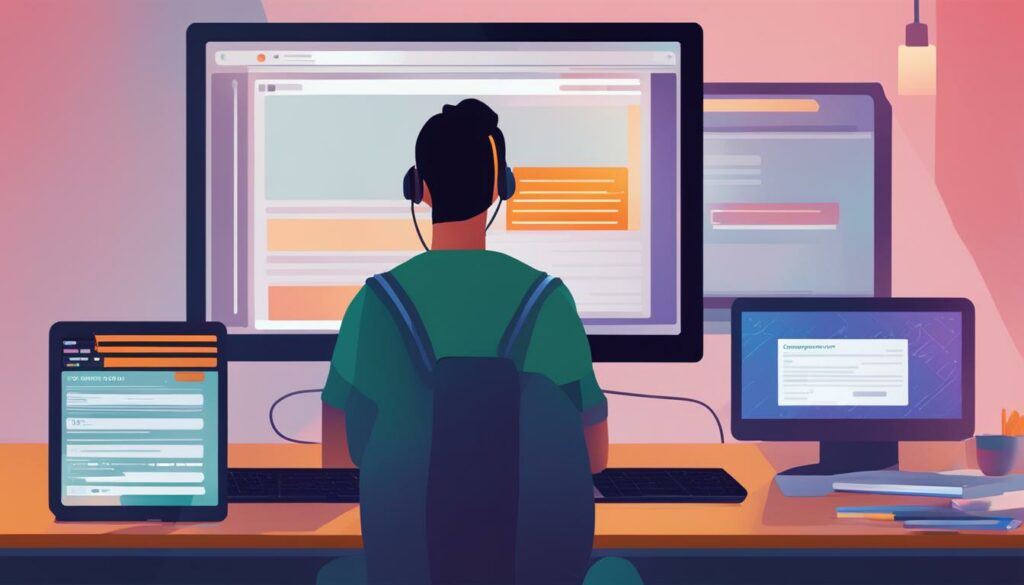When users encounter an error on a website, it can be a frustrating experience. However, businesses can turn this situation into an opportunity to provide a better user experience through custom error pages. By designing personalized error pages, you can not only enhance your branding and SEO efforts but also improve overall user satisfaction.
Custom error pages allow you to create a unique and engaging experience for your visitors when they encounter errors such as 404 page not found. With customized designs, clear messaging, and relevant solutions, you can guide users back to the desired content and reduce their frustration.
Personalizing your error pages also gives you the chance to showcase your brand’s personality, maintaining consistency in your design and tone. This creates a cohesive user experience and reinforces your brand identity while providing assistance so users can easily navigate back to your website’s main pages or find useful resources.
Key Takeaways:
- Custom error pages improve user experience and satisfaction.
- Personalized error pages enhance branding and SEO efforts.
- Clear messaging and relevant solutions help users navigate back to desired content.
- Custom error pages provide an opportunity to showcase your brand’s personality.
- Consistency in design and tone reinforces brand identity.
Sign up now for BoostedHost’s WordPress Hosting for optimal performance and to unlock even more customization options for your error pages. BoostedHost offers reliable hosting services tailored for WordPress websites, ensuring a smooth and seamless experience for your visitors. Take control of your error pages and provide a better user experience today!
Click here to sign up for WordPress Hosting from BoostedHost.
The Importance of Error Pages in Website Design
Error Pages are an essential part of website design, particularly from a user experience (UX) perspective. When users encounter an error, it can be a frustrating experience, but a well-designed error page can turn it into an opportunity to showcase the brand’s personality and provide helpful information.
An error page should be designed with clear navigation, functionality, and a focus on presenting the brand in a cohesive manner. It should guide users back to their intended destination and minimize any disruption to their browsing experience. By incorporating user-friendly elements into the error page, such as an easily identifiable navigation menu, users are more likely to navigate to other relevant parts of the website.
Additionally, a well-designed error page can positively impact the brand presentation. It allows businesses to express their unique brand voice, visual identity, and company values, even when something goes wrong. This helps to maintain consistency across the website and reinforces the brand image in the users’ minds.
One essential aspect of error page design is to prioritize user experience. By providing clear and concise error messages, users can quickly understand what went wrong and how they can resolve the issue. This reduces frustration and cognitive friction, promoting a positive user experience and increasing the chances of retaining visitors on the website.
“A well-designed error page can turn a frustrating error into an opportunity to engage users and guide them back to their desired content.” – BoostedHost
Incorporating UX principles into error page design also includes minimizing the frustration caused by common errors, such as broken links or mistyped URLs. By providing suggestions or alternative links to similar content, users can continue their browsing journey seamlessly. A helpful error page can transform what would have been a negative experience into a chance for discovery and exploration on the website.
To illustrate the importance of error pages in website design, let’s take a look at an example:
| Error Page Attribute | Importance |
|---|---|
| Clear Navigation | High |
| Brand Presentation | High |
| User-Friendly Elements | High |
| Clear and Concise Messaging | High |
| Providing Alternative Links | Medium |
In this example, the error page design prioritizes clear navigation, consistent brand presentation, and user-friendly elements. The messaging is concise and guides users to take appropriate actions, ensuring a positive user experience. Additionally, the provision of alternative links helps users explore similar content and keeps them engaged on the website.
The importance of error pages in website design cannot be overstated. By focusing on user experience, functionality, brand presentation, and navigation, businesses can transform frustrating errors into opportunities to reinforce their brand image and provide a positive browsing experience for their users.
Different Types of Errors
When browsing the web, you may come across various types of errors that can be frustrating and disrupt your experience. Understanding these errors is essential for effective troubleshooting and designing custom error pages that cater to each specific situation. Here are some common types of errors:
- Error 400 (Bad Request): This error occurs when the server cannot understand your request, usually due to invalid syntax or missing parameters. It could be a result of a mistyped URL or unsupported file format.
- Error 401 (Unauthorized): When you encounter this error, it means that you are trying to access restricted content or perform an action that requires authentication. You may need to enter valid credentials to proceed.
- Error 403 (Forbidden): This error indicates that you do not have permission to access the requested resource. It could be due to insufficient privileges or IP blocking.
- Error 404 (Not Found): The most well-known error, 404, occurs when the server cannot find the requested content. It happens when a page has been deleted, moved, or renamed, resulting in a broken link.
- Error 500 (Internal Server Error): This error is a generic server-side error that occurs when the server encounters an unexpected condition that prevents it from fulfilling the request. It could be due to misconfiguration, programming errors, or server overload.
- Error 503 (Service Unavailable): When you see this error, it means that the server is temporarily unable to handle the request, usually due to maintenance or overload. It’s a temporary error, and the service should be back online soon.
By familiarizing yourself with these error types, you can better navigate and resolve issues that may arise during your web browsing experience.

Creating custom error pages tailored to these specific errors can improve user experience by providing clear explanations, relevant solutions, and a consistent brand presence. In the next section, we will delve into the definition of custom error pages and their significance in web design.
Defining Custom Error Pages
Custom Error Pages are designed specifically to be displayed when a user encounters an error on a website. These errors can be caused by various factors, including link rot (redirecting to a non-existent page), an incorrectly entered address by the user, server errors, or other communication problems.
Custom error pages serve a dual purpose. Firstly, they inform users about the error they encountered, providing clarity and reassurance. Secondly, they offer possible solutions and guidance to help users navigate back to the desired content or resolve the error themselves.
When it comes to error page appearance and design, businesses have the opportunity to showcase their brand identity and engage with users in a meaningful way. By incorporating relevant visuals, clear messaging, and intuitive navigation elements, custom error pages can transform a frustrating error into a positive user experience.
Here is an example custom error page that demonstrates how a creative design, informative messaging, and a user-friendly interface can effectively guide users:
| Error Type | Error Description | Possible Solution |
|---|---|---|
| Link Rot | The page you are trying to access no longer exists or has been moved. | Check the address for any typos, or use the search bar to find the desired content. |
| Incorrect Address | The address you entered is not valid. | Verify the address and try again. Ensure the spelling and formatting are correct. |
| Server Error | An internal server error prevents the page from being displayed. | Refresh the page or try again later. If the problem persists, contact the website administrator. |
By implementing custom error pages that address common errors and provide helpful solutions, businesses can enhance user experience and ensure that visitors stay engaged and satisfied, even in the face of errors.
The Impact of Custom Error Pages on User Experience
Custom Error Pages have a significant impact on the overall user experience. When users encounter an error while navigating a website, it can evoke negative emotions, causing frustration and cognitive friction.
Well-designed custom error pages play a crucial role in alleviating these negative experiences by providing clear explanations of the error and offering helpful solutions.
A custom error page with a positive and helpful tone can reassure users and guide them towards resolving the error.

Reducing Stress and Friction
By addressing users’ frustrations and concerns, custom error pages help reduce stress and cognitive friction. These pages provide an opportunity to communicate effectively with users and keep them engaged even in error situations, leading to a more positive experience.
A well-designed custom error page can instill confidence in users and make them feel that the website cares about their needs.
Enhancing User Flow and Usability
Custom error pages also contribute to the overall user flow and usability of a website. By providing relevant information and guidance, these pages help users navigate back to their intended destination or explore alternative options.
Additionally, custom error pages can serve as an entry point to other sections of the website, offering users the opportunity to discover new content or products while resolving the error.
Impact of Custom Error Pages on User Experience
| Benefits | Impact on User Experience |
|---|---|
| Reduces stress and frustration | Provides clear explanations and solutions to guide users |
| Improves engagement | Maintains a positive and helpful tone to retain users |
| Enhances usability | Offers alternative options and promotes seamless navigation |
Overall, custom error pages are a powerful tool in creating a user-friendly website. By addressing users’ emotions, reducing cognitive friction, and ensuring a smooth user flow, these pages contribute to a positive user experience, improved usability, and increased customer satisfaction.
Best Practices for Designing Custom Error Pages
When it comes to designing custom error pages, there are several best practices that can help you create a seamless user experience. By following these guidelines, you can ensure that your error pages effectively address errors and provide clear solutions to your users.
1. Keep it Simple and Clear
Design your custom error pages with simplicity in mind. Clear messaging is essential to guide your users and help them understand what went wrong. Avoid cluttered designs and focus on delivering a straightforward error message that is easy to comprehend.
2. Maintain Brand Consistency
Consistency is key when it comes to designing custom error pages. Ensure that your error pages reflect your brand’s visual identity, including your logo, color scheme, and typography. This will help users recognize your website even when they encounter an error, maintaining brand consistency throughout their browsing experience.
3. Incorporate Humor Cautiously
Humor can be a great way to engage users on error pages, but it needs to be used cautiously. Consider incorporating witty messages or humorous imagery that aligns with your brand’s tone and personality. However, be mindful of the error context and avoid jokes that may offend or confuse your users.
4. Leverage Business Opportunities
Custom error pages present a unique opportunity to promote your products or direct users to relevant content. Consider including links or calls to action that can help users explore other parts of your website while they navigate away from the error page. This can lead to potential business opportunities and keep users engaged with your brand.
Summary
Designing custom error pages requires simplicity, clear messaging, brand consistency, and a careful use of humor. By following these best practices, you can turn error pages into valuable touchpoints that enhance the user experience and present new business opportunities.

How to Implement Custom Error Pages on Your Website
To provide a seamless user experience on your website, it is essential to implement custom error pages. These pages can be personalized to effectively address errors and guide users back to the desired content. Here’s a step-by-step guide on how to implement custom error pages:
Step 1: Server Configuration
Configure your web server to display the custom error page instead of the default server error page. The process may vary depending on the web server you are using. Below are some common web servers and their configuration methods:
| Web Server | Configuration Method |
|---|---|
| Apache | Edit the .htaccess file or the server configuration file (httpd.conf) |
| Nginx | Edit the server configuration file (nginx.conf) |
| IIS | Use Internet Information Services (IIS) Manager to configure error pages |
Make sure to specify the correct file path for your custom error page in the server configuration.
Step 2: Testing
After configuring your server to display custom error pages, it is crucial to test the implementation. Visit your website and deliberately trigger different types of errors (such as entering an incorrect URL or accessing a restricted page). Verify that the custom error pages are displayed correctly and provide the relevant information to users.
Step 3: Web Analytics Tracking
Add web analytics tracking to your custom error pages to gather insights on user behavior. This will help you understand how users navigate through error pages and identify opportunities for improvement. Use tools like Google Analytics to track metrics such as bounce rate, exit rate, and the number of users who return to your website after encountering an error.
Implementing custom error pages, configuring the server, testing the implementation, and tracking web analytics are crucial steps to ensure a seamless user experience on your website. By following these steps, you can effectively address errors and guide users back on track.
BoostedHost recommends WordPress Hosting for optimal performance. Sign up now through this link: www.boostedhost.com/wordpress-hosting.
Examples of Effective Custom Error Pages
When it comes to custom error pages, there is no shortage of creative designs and user-friendly interfaces that effectively represent brands and engage users. These examples showcase the power of humor, clear messaging, relevant navigation options, and brand-consistent visuals in guiding users back to the desired content.
1. “The Lost Astronaut” by Earthly Delights Co.
This error page from Earthly Delights Co. features a playful design where an astronaut keeps floating around the screen, trying to find their way back to Earth. The use of humor adds an element of surprise and lightens the frustration of encountering an error. The clear messaging and navigation prompts ensure that users can quickly return to the main website.
Stellar Corp. takes a lighthearted approach with their error page by incorporating a space-themed concept. The page humorously informs users that they have run out of oxygen and need to return to the homepage to refill. The visually appealing design, complete with stars and a comical astronaut illustration, creates a memorable and user-friendly experience.
3. “404: The Treasure Hunt Continues” by Pirate Cove Adventures
Pirate Cove Adventures uses a pirate-themed custom error page to turn a 404 error into a treasure hunt adventure. The page presents users with a map and clues to search for hidden treasures on the website. This interactive approach not only engages users but also encourages them to explore other content on the site, providing a positive user experience.
4. “Let’s Dance! We Apologize for the Mishap” by GrooveNation
GrooveNation’s error page adds a fun and engaging twist by incorporating a dancing animation. The page apologizes for the mishap and invites users to join the virtual dance party while they wait for the issue to be resolved. This creative approach injects humor and entertains users, ensuring they stay engaged with the brand.
Key Takeaways:
- Custom error pages can incorporate humor, clear messaging, and relevant navigation options.
- Visually engaging designs and user-friendly interfaces enhance the user experience.
- By studying these examples, businesses can gain inspiration to create their own custom error page designs.
Remember, when designing custom error pages, it’s important to consider your brand representation, usability, and the overall experience you want to provide to your users.
Conclusion
Custom Error Pages are an integral part of web design, playing a vital role in enhancing the user experience and promoting branding and usability on websites. By designing user-friendly, informative, and visually appealing custom error pages, businesses can ensure a positive user experience and maintain a strong brand image.
To create effective custom error pages, it is crucial to provide clear explanations and helpful solutions to guide users back to their desired content. Additionally, maintaining a cohesive brand presence throughout the error page helps reinforce brand recognition and consistency.
With the right design and implementation, custom error pages can transform frustrating errors into valuable opportunities to engage users. By prioritizing the user experience and leveraging the power of design, businesses can turn error pages into a positive aspect of their website, enhancing user satisfaction and driving overall success.
For optimal performance and seamless website management, we recommend BoostedHost’s WordPress Hosting. Sign up now through this link to experience the benefits of reliable hosting and exceptional user experience.
FAQ
Q: What are Custom Error Pages?
A: Custom Error Pages are pages specifically designed to be displayed when a user encounters an error on a website. They provide information about the error and offer solutions to help users navigate back to the desired content.
Q: Why are Custom Error Pages important?
A: Custom Error Pages play a significant role in enhancing the user experience on a website. They help maintain brand consistency, improve SEO efforts, and provide a positive and helpful user experience when users encounter errors.
Q: What types of errors can users encounter?
A: Users can encounter various errors while browsing the web, including Error 400 (Bad Request), Error 401 (Unauthorized), Error 403 (Forbidden), Error 404 (Not Found), Error 500 (Internal Server Error), and Error 503 (Service Unavailable).
Q: How do Custom Error Pages impact user experience?
A: Custom Error Pages have a significant impact on user experience. When users encounter an error, well-designed custom error pages can provide clear explanations, offer solutions, and maintain a positive and helpful tone, reducing frustrations and improving user satisfaction.
Q: What are some best practices for designing Custom Error Pages?
A: Best practices for designing Custom Error Pages include keeping the design simple and focused on clear messaging, maintaining brand consistency, using humor cautiously, and leveraging business opportunities to promote products or direct users to relevant content.
Q: How do I implement Custom Error Pages on my website?
A: Implementing Custom Error Pages involves configuring the server to display the custom error page instead of the default server error page. This can be done through server configuration settings that vary depending on the web server used.
Q: Are there any examples of effective Custom Error Pages?
A: Yes, there are numerous examples of effective Custom Error Pages that showcase creative designs, user-friendly interfaces, and effective brand representation. These examples can provide inspiration for designing unique and engaging error pages.












